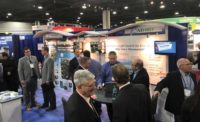Fueling the growth has been the saturation of central air conditioning in buildings.
Way back in 1960, central cooling saturation of the country’s housing stock was less than 10%, a figure that has grown to just over 50% today. Another 25% of American homes have one or more window air conditioners.
Behind this growing saturation has been the tremendous output of homes and of the heating and cooling equipment that went into them. The country today counts 100 million housing units, of which about 67% are single-family detached, the remainder multifamily units in buildings.
Another 5 million nonresidential buildings (commercial, institutional, retail, offices, etc.) absorb big systems: boilers, chillers, and large unitary equipment.
Unitary shipments, including heat pumps, were fewer than 1 million the year that John F. Kennedy won the White House. That output, measured at the starting point of each new decade, nearly doubled, and is expected to easily exceed 6 million at the start of 2000 (see the chart above).
Another measure of unitary shipments, the cumulative total for each of the four decades, shows just under 8 million shipments for the entire 1960s. This output tripled in the 70s, grew by 40% in the 1980s, and will have seen a growth of 55% to 49.1 million by the end of this decade (see chart on page 21).
By far, the most common heating system in U.S. homes has been the gas furnace. Output of this product started at a higher base in 1960, with about 12 million of them shipped during the period. Output in the 1970s (16.3 million) was 34% higher, and grew again in the 1980s to 18.1 million, a gain of 11%.
The 1990s will have seen shipments of 25.5 million, a 40% hike (see chart, far left).
Replacement mulch and new growth
The replacement of this very large base of installed heating and cooling equipment represents more than 50% of each year’s output, and promises to moderate the historic volatility of this weather-related industry.Another market for central cooling is the new single-family house market.
In 1960, about 200,000 new homes had central cooling built in. At the beginning of each successive decade, the growth has been steady: up 80% in 1970, up 66% in 1980, up 22% in 1990, and projected to be up 35% by the start of the next decade (see top chart).
Each decade’s cumulative output of large-tonnage chillers, as recorded by the Air-Conditioning and Refrigeration Institute (ARI), shows a different pattern. It was virtually flat (around 23,000) in the 1960s and 70s, followed in the 1980s by a 68% surge to 38,476, and a striking 84% increase in the 1990s to more than 70,000. Much of the latter gain is due to exports, says ARI (see middle chart).
Really big numbers are recorded for compressor body shipments, used in a host of air conditioning and refrigeration products.
During the 1960s, output was 142.8 million units, growing to 245.4 million in the 1970s. This dipped to 237 million in 1980, but will have grown by 24% to 294.8 million at the end of this decade (see bottom chart).
These boxcar numbers do not begin to account for related products like valves, temperature controls, relays, fans, air-handling equipment, piping, refrigerants, duct systems, and other critical parts of heating-cooling systems.
Nor do they include products like commercial refrigeration equipment, humidifiers, air cleaners, central-station air handlers, cooling towers, fancoil units, ptac’s, and pthp’s.





